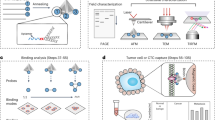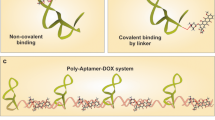Abstract
Nucleic acid aptamers are regarded as rivals for antibodies and as such are being investigated for their therapeutic potential. In the present work, it is shown that two different high-affinity DNA aptamers developed previously by Ferreira et al. against MUC1 antigen (designated MUC1-5TR-1 and MUC1-S1.3/S2.2) on MCF7 breast cancer cells can be linked to the first component of complement (C1q) via a biotin–streptavidin system and induce significant killing of MCF7 cells in vitro. Cell viability was assessed by Trypan blue uptake and absorbance at 590 nm of stained cells following buffer washes and lysis in 1% SDS. While the killing effect is demonstrable versus various controls, dependent on aptamer dose, and reproducible, it appears to kill maximally about half of treated MCF7 cells. Possible reasons for the marginal killing effect include antigenic shedding in vitro and membrane-bound complement regulatory proteins (mCRPs) on the cell surface such as CD46, CD55, and CD59 which act to inhibit complement-mediated lysis of cells. Future in vitro research could benefit from application of mCRP-specific aptamers in combination with anti-MUC1 aptamers to overcome surface protective mechanisms while attacking the plasma membrane of MCF7 cells or other MUC1-expressing cancer cells. However, in vivo such a combination could have deleterious effects on normal MUC1-expressing cells as well.




Similar content being viewed by others
References
Borbas K. E.; Ferreira C. S. M.; Perkins A.; Bruce J. I.; Missailidis S. Design and synthesis of mono- and multimeric targeted radiopharmaceuticals based on novel cyclen ligands coupled to anti-MUC1 aptamers for the diagnostic imaging and targeted radiotherapy of cancer. Bioconj. Chem. 18: 1205–1212; 2007.
Bruno J. G.; Carrillo M. P.; Cadieux C. L.; Lenz D. L.; Cerasoli D. M.; Phillips T. DNA aptamers developed against a soman derivative cross-react with methylphosphonic acid but not with the flanking hydrophobic groups. J. Molecular Recognition. 22: 197–204; 2008a.
Bruno J. G.; Carrillo M. P.; Crowell R. Preliminary development of DNA aptamer-Fc conjugate opsonins. J. Biomed. Mater. Res. A. 90: 1152–1161; 2008b.
Bruno J. G.; Carrillo M. P.; Phillips T. Effects of immobilization chemistry on enzyme-linked aptamer assays for Leishmania surface antigens. J. Clin. Ligand Assay 30: 37–43; 2007.
Bruno J. G.; Carrillo M. P.; Phillips T. In vitro antibacterial effects of anti-lipopolysaccharide DNA aptamer-C1qrs complexes. Folia Microbiol. 53: 295–302; 2008c.
Bruno J. G.; Carrillo M. P.; Phillips T.; King B. Development of DNA aptamers for cytochemical detection of acetylcholine. In Vitro Cell. Develop. Biol.—Animal 44: 63–72; 2008d.
Cerchia L.; Giangrande P. H.; McNamara J. O.; de Francisics V. Cell-specific aptamers for targeted therapies. Methods Mol. Biol. 535: 59–78; 2009.
Chan A. K.; Lockhart D. C.; von Bernstorff W.; Spanjaard R. A.; Joo H. G.; Eberlein T. J.; Goedegebuure P. S. Soluble MUC1 secreted by human epithelial cancer cells mediates immune suppression by blocking T-cell activation. Int. J. Cancer. 82: 721–726; 1999.
Chen J.; Xu X. M.; Underhill C. B.; Yang S.; Wang L.; Chen Y.; Hong S.; Creswell K.; Zhang L. Tachyplesin activates the classic complement pathway to kill tumor cells. Cancer Res. 65: 4614–4622; 2005.
Chu T. C.; Marks J. W.; Lavery L. A.; Faulkner S.; Rosenblum M. G.; Ellington A. D.; Levy M. Aptamer: toxin conjugates that specifically target prostate tumor cells. Cancer Res. 66: 5989–5992; 2006.
Danielczyk A.; Stahn R.; Faulstich D.; Löffler A.; Märten A.; Karsten U.; Goletz S. PankoMab: a potent new generation anti-tumour MUC1 antibody. Cancer Immunol. Immunother. 55: 1337–1347; 2006.
Donin N.; Jurianz K.; Ziporen L.; Schultz S.; Kirschfink M.; Fishelson Z. Complement resistance of human carcinoma cells depends on membrane regulatory proteins, protein kinases and sialic acid. Clin. Exp. Immunol. 131: 254–263; 2003.
Farkas I.; Baranyi L.; Ishikawa Y.; Okada N.; Bohata C.; Budai D.; Fukuda A.; Imai M.; Okada H. CD59 blocks not only the insertion of C9 into MAC but inhibits ion channel formation by homologous C5b-8 as well as C5b-9. J. Physiol. 539.2: 537–545; 2002.
Ferreira C. S. M.; Cheung M. C.; Missailidis S.; Bisland S.; Gariepy J. Phototoxic aptamers selectively enter and kill epithelial cancer cells. Nucl. Acids Res. 37: 866–876; 2009.
Ferreira C. S. M.; Matthews C. S.; Missailidis S. DNA aptamers that bind to MUC1 tumour marker: design and characterization of MUC1-binding single-stranded DNA aptamers. Tumor Biol. 27: 289–301; 2006.
Ferreira C. S. M.; Papamichael K.; Guilbault G.; Scharzacher T.; Gariepy J.; Missailidis S. DNA aptamers against the MUC1 tumour marker: design of aptamer-antibody sandwich ELISA for the early diagnosis of epithelial tumours. Anal. Bioanal. Chem. 390: 1039–1050; 2008.
Halulinen J.; Meri S. Complement-mediated killing of microtumors in vitro. Am. J. Pathol. 153: 845–855; 1998.
Hicke B. J.; Stephens A. W.; Gould T.; Chang Y. F.; Lynott C. K.; Heil J.; Borkowski S.; Hilger C. S.; Cook G.; Warren S.; Schmidt P. G. Tumor targeting by an aptamer. J. Nucl. Med. 47: 668–678; 2006.
Huang Y. F.; Shangguan D.; Liu H.; Phillips J. A.; Zhang X.; Chen Y.; Tan W. Molecular assembly of an aptamer-drug conjugate for targeted drug delivery to tumor cells. Chembiochem. 10: 862–868; 2009.
Ireson C. R.; Kelland L. R. Discovery and development of anticancer aptamers. Mol. Cancer Ther. 5: 2957–2962; 2006.
Moffitt M. C.; Frank M. M. Complement resistance in microbes. Springer Semin. Immunopathol. 15: 327–344; 1994.
Moreno M.; Bontkes H. J.; Scheper R. J.; Kenemans P.; Verheijen R. H. M.; von Mensdorff-Pouilly S. High levels of MUC1 in serum of ovarian and breast cancer patients inhibits huHMFG-1 dependent cell-mediated cytotoxicity (ADCC). Cancer Lett. 257: 47–55; 2007.
Pendergast P. S.; Marsh H. N.; Grate D.; Healy J. M.; Stanton M. Nucleic acid aptamers for target validation and therapeutic applications. J. Biomolec. Techniques. 16: 224–234; 2005.
Rubinstein D. B.; Karmely M.; Pichinuk E.; Ziv R.; Benhar I.; Feng N.; Smorodinsky N. I.; Wreschner D. H. The MUC1 oncoprotein as a functional target: immunotoxin binding to α/β junction mediates cell killing. Int. J. Cancer. 124: 46–54; 2009.
Sefah K.; Tang Z. W.; Shangguan D. H.; Chen H.; Lopez-Colon D.; Li Y.; Parekh P.; Martin J.; Meng L.; Phillips J. A.; Kim Y. M.; Tan W. H. Molecular recognition of acute myeloid leukemia using aptamers. Leukemia 23: 235–244; 2009.
Storr S. J.; Royle L.; Chapman C. J.; Abd Hamid U. M.; Robertson J. F.; Murray A.; Dwek R. A.; Rudd P. M. The O-linked glycosylation of secretory/shed MUC1 from an advanced breast cancer patient’s serum. Glycobiol 18: 456–462; 2008.
Uliasz T. F.; Hewett S. J. A microtiter trypan blue absorbance assay for the quantitative determination of excitotoxic neuronal injury in cell culture. J. Neurosci. Methods 100: 157–163; 2000.
Ulrich H.; Magdesian M. H.; Alves M. J.; Colli W. In vitro selection of RNA aptamers that bind to cell adhesion receptors of Trypanosoma cruzi and inhibit cell invasion. J. Biol. Chem. 277: 20756–20762; 2002.
Wang S. Y.; Weiner G. Complement and cellular cytotoxicity in antibody therapy of cancer. Expert Opin. Biol. Ther. 8: 759–768; 2008.
Yan J.; Allendorf D. J.; Li B.; Yan R.; Hansen R.; Donev R. The role of membrane complement regulatory proteins in cancer immunotherapy. Adv. Exp. Med. Biol. 632: 159–174; 2008.
Acknowledgment
Work was funded internally by Operational Technologies Corp.
Author information
Authors and Affiliations
Corresponding author
Additional information
Editor: J. Denry Sato
Rights and permissions
About this article
Cite this article
Bruno, J.G. Aptamer–biotin–streptavidin–C1q complexes can trigger the classical complement pathway to kill cancer cells. In Vitro Cell.Dev.Biol.-Animal 46, 107–113 (2010). https://doi.org/10.1007/s11626-009-9257-7
Received:
Accepted:
Published:
Issue Date:
DOI: https://doi.org/10.1007/s11626-009-9257-7




